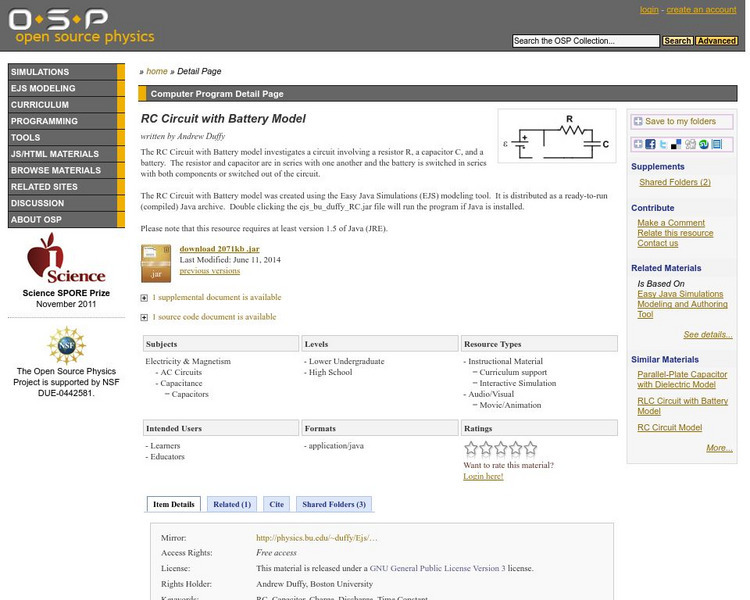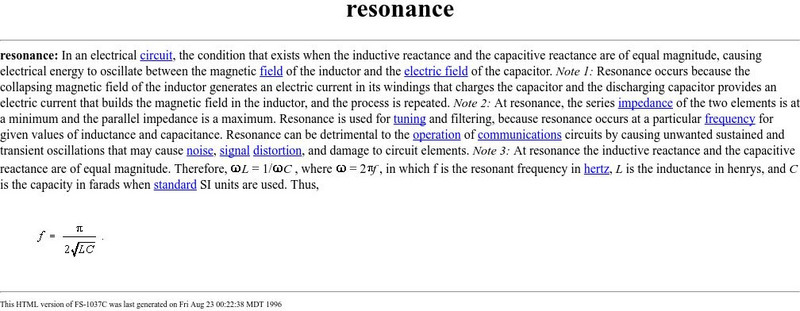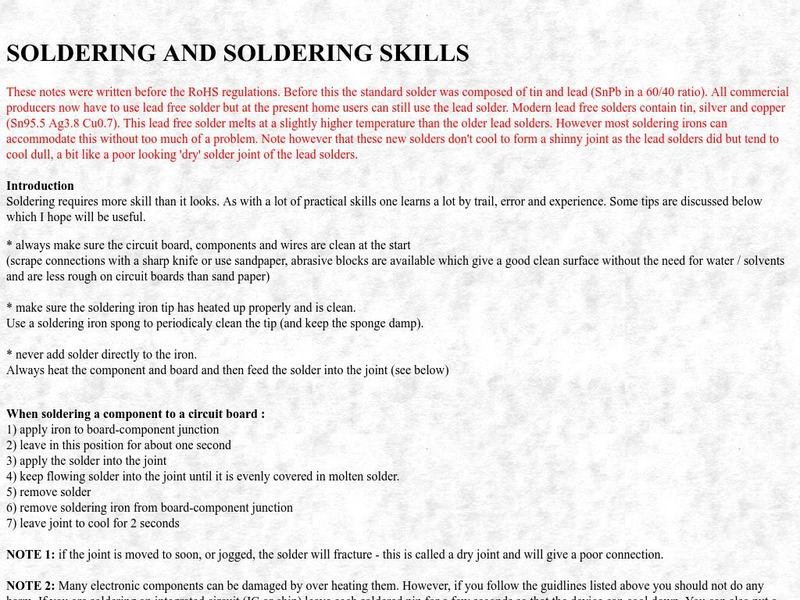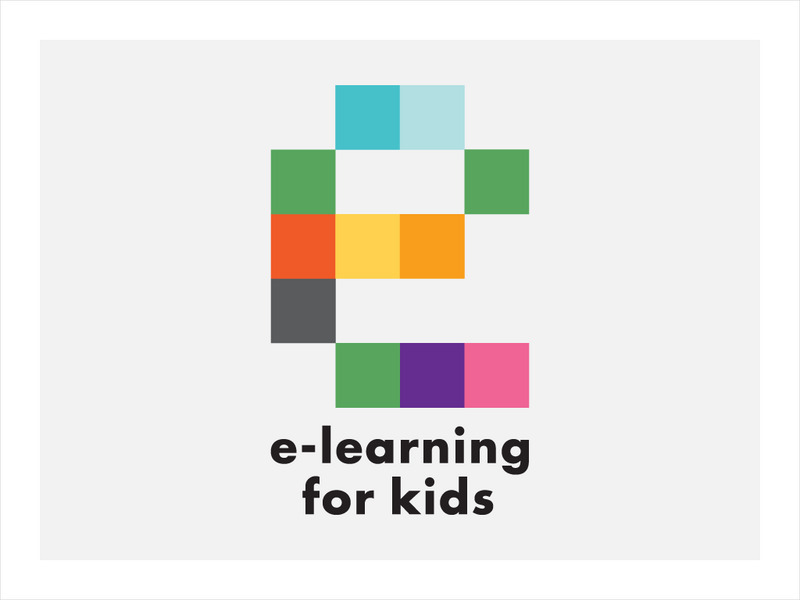Science Buddies
Science Buddies: Sliding Light: How to Make a Dimmer Switch With a Pencil
In this electronics science fair project, students will make a simple dimmer switch and investigate the relationship between the resistance in the circuit and the amount of light produced. The Science Buddies project ideas are set up...
American Association of Physics Teachers
Com Padre Digital Library: Open Source Physics: Rlc Circuit Function Generator
An electrical circuit simulation modeling a resistor, capacitor, and inductor in a series. Vary the resistance, capacitance, inductance and source frequency in the simulation.
Maryland Science Center
Maryland Science Center: Happy Birthday, Harry Potter! [Pdf]
Using your knowledge of electricity, learn how to make a 'magic' wand like Harry Potter's that will light up on your command.
Science Struck
Science Struck: Lcr Meter Working Principle and Uses
Explains what an LCR meter is and how it is used to measure the inductance, capacitance, and resistance of a circuit. Lists the different parameters of a circuit that it measures, describes two types of LCR meters, and gives definitions...
American Association of Physics Teachers
Com Padre Digital Library: Open Source Physics: Rc Circuit With Battery Model
Simulation showing the simplest RC circuit, with a resistor and capacitor in series with one another, and a battery that can be switched in the series, or switched out of the circuit.
Science Struck
Science Struck: Amperage vs. Voltage What Is the Difference?
This article explains what voltage and amperage are and the effect batteries have on them in an electrical circuit.
Science and Mathematics Initiative for Learning Enhancement (SMILE)
Smile: Electric Currents and Circuits
This cooperative learning activity for intermediate to junior high pupils has them create various electrical circuits in order to understand electricity.
Utah State Office of Education
Utah Science: The Mysterious Force
There is a secret mysterious force in your home right this very moment! Try these activities to first identify that force and then extend your knowledge of the force by investigating the other activities provided.
Technovation
Curiosity Machine: Challenges: Engineer an Electric Switch
Using your knowledge of the flow of electricity, do you think you could build a switch that can complete a circuit to turn on an LED? This site contains the challenge, tips, a lesson plan, and a place for students to document their...
Curated OER
Science Kids: Science Images: Electricity Circuit Diagram
This basic electricity circuit diagram shows a resistor and ammeter in series, a voltmeter in parallel and a switch with a cell for charging purposes.
Khan Academy
Khan Academy: Electrical Engineering: Amplifiers
Amplifiers make signals bigger. Amplification is often the most basic operation of an electronic circuit. There are many kinds of amplifier designs. We will describe the operational amplifier, the building block of most analog electronics.
Khan Academy
Khan Academy: Dc Circuit and Electrical Power Review
Review the components of a circuit and their symbols such as battery, resistor, and switch. Analyze how the power of a resistor is related to the current and electric potential difference across the resistor.
Khan Academy
Khan Academy: Basic Electrical Quantities: Current, Voltage, Power
Build an intuitive understanding of current and voltage, and power.
Khan Academy
Khan Academy: Electric Potential Difference and Ohm's Law Review
Review the key terms, equations, and skills related to Ohm's law, including how electric potential difference, current, and resistance are related.
Other
Institute for Telecommunication Sciences: Resonance
This site contains a straightforward definition of resonance in an electrical circuit.
Creative Science Centre
Creative Science Centre: Soldering and Soldering Skills
Soldering requires more skill than it looks. As with a lot of practical skills one learns a lot by trail, error and experience. Some tips are discussed here. These notes were written before regulations were introduced requiring solder to...
E-learning for Kids
E Learning for Kids: Science: Arctic Ocean: What Are Conductors and Insulators?
Visit Vlad and learn about the properties of conductors and insulators, and what materials are used for them.
Channel 4 Learning
4 L: Science Essentials: Get Physical
Find a review of many aspects of the physical world. Simple explanations of electricity, gravity, and the solar system. Included are materials for teachers to use for enrichment.
Creative Science Centre
Creative Science Centre: Led's
There are so many different types of LEDs on the market (even of the same size and color), how do you tell the difference between them and which one you should use for your particular application? The simple tests descibed here compare...
Ducksters
Ducksters: Physics for Kids: Electronic Circuits
Kids learn about electronic circuits in the science of electricity and physics including schematics, power, ground, components, and the printed circuit board.
Khan Academy
Khan Academy: Application of the Fundamental Laws
We solve a circuit by direct application of the fundamental laws: Apply element laws (Ohm's Law and the like) plus Kirchhoff's Laws to solve for the currents and voltages of a circuit.
Science Education Resource Center at Carleton College
Serc: Learning the Science Behind Electricity
Following a PowerPoint lecture, students will participate in a laboratory investigation where they dissect a disposable camera.
CK-12 Foundation
Ck 12: Physical Science: Thermal Conductors and Insulators
[Free Registration/Login may be required to access all resource tools.] Thermal conductors and insulators and the ways they are used.
Science Struck
Science Struck: Lemon Battery Experiment
In this step-by-step experiment, you will learn how to make a battery using four lemons and use it to light an LED bulb.
















